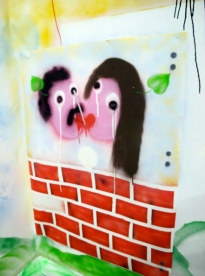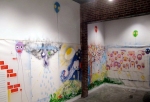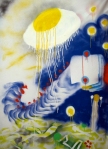Looking back ten years ago you would be hard pressed to find a painting exhibition in Chelsea, NYC or any ‘traditional’ medium’ for that matter. Right now Chelsea is awash with painting and sculpture exhibitions. Two of which supported the strong lineup of exhibition on West 22nd street in New York City’s Chelsea art district. Erin Treacy takes a look.
Paintings take multiple dimensions when eight women investigate abstraction through process and practice.
Affinities: Painting in Abstraction– curated by Kate McNamara
30 June – 19 August, D’amelio Terras
Curated by Kate McNamara, Affinities-Painting in Abstraction at D’amelio Terras surprised me when it did not focus on two-dimensional work. Though in retrospect, “painting” in the title, refers to a verb and not a noun. Throughout the exhibition the artwork presented questioned the very word painting; is it a verb, an adjective, a noun, neither, or all.
Polly Apfelbaum works in plasticine and polymer seem to want to be hung on a wall yet are displayed on a table. The question of what is painting arises in Afpelbaum’s pieces because color is an inherent quality of the material, there is of course the possibility that she is applying oil paint on the material as an after-act or that pigment is being mixed with the material therefore making it an adjective to describe the “red” plasticine or the “blue” polymer clay. Therefore she does not apply color to a material, she uses a colored material to create a composition, that is essential two-dimensional. These pieces morph colored material into a new composition, which can be collage, assemblage, and/or sculpture. Is this painting? I am not convinced, and in her interview with Roxanna Marcoci of The Museum of Modern Art Interviews, neither is she. She discusses her work as “hybrids between painting and sculpture”[1]. It is true in much of her work there is always reliance on two dimensionality, which often falls under “painting”, yet the work is composed of colored objects. Her contemporary Jean Shin, is a good comparison in this hybrid of sculpture and painting, where the focus on palette and arrangement of color acts to define itself as painting. Apfelbaum’s pieces use bold shapes and limited palette which act as signifiers; allowing the opportunity to be interpreted in multiple ways and never commit to a specific action or notion. References to Richard Serra summer drawing retrospective at the Metropolitan Museum of Art, NY, are apparent.
Nicole Cherubini presentation on contemporary ceramics where paint acts as the union between disparate mediums presents painting as a verb, creating some of the most successful pieces in the exhibition, Cherubini follows suit with Apfelbaum, merging the disciplines of sculpture and painting. The sculptural aspects and applied paint in Yellow (All the King’s Horses) 2011, act separately to create painted sculptures. As if painting is just another piece of material that is used in her sculpture; medium: wood, ceramics, painting.
Laurel Sparks works on traditional canvas, but in addition to painting she is using assemblage while letting the material fulfill its duties to communicate with the entire composition. From a distance I am entranced by Sparks paintings, the composition is welcoming, swaying between open and closed spaces, the positive and negative space seamlessly active, the amorphous shapes undulating against the areas of pattern work. There is a collective balance projected that is needed in current trends. Thinking back on previous exhibitions of sensational work that begs for disruption and dis-pleasure in the audience, Sparks paintings are refreshing. Yet, as I approach the painting the barrage of material becomes apparent and I immediate become fearful that she is commenting on consumerism and pull away from the trite use of found plastics and glitter. Sparks work pays homage to Pop Art, highlighting the ever-prominent discussion of consumerism and over-indulgence that plagues many American artists.
This group exhibition includes work by artists Polly Apfelbaum, Nicole Cherubini, Joanne Greenbaum, Suzanne McClelland, Jenny Monick, Carrie Moyer, Dona Nelson and Laurel Sparks. Each artist questions the means and the ends of painting in contemporary art, quite clearly demonstrating that as contemporary theory re-appropriates art history, so does contemporary artist re-appropriate the act of art making. Expanding the boundaries of what painting is, by paying homage to the breadth of this medium.
I am impressed with Kate McNamara choice of artists and ability to demonstrate the diversity in the medium within a constrained curation. The show finds unity in the clear presentation of non-representational imagery. One could easily gather a slop-feast of artist who ‘use’ color in their practices, but do not think about painting in their conceptual approach. Each artist in this exhibition demonstrates a knowledge of painting history from Apfelbaum’s references to Robert Motherwell with appropriation of color fields and signifiers, to Sparks use of continually morphing organic shapes that call to the likes of Arshile Gorky. One thing is clear; homage to Modernism has resurfaced on contemporary “painting”. The fact that the artists selected are all women, begged research, and McNamara has chosen not to discuss this piece of the puzzle. Surprising is that this exhibition has taken form in two other venues. The first (2007) and second (2009) exhibits were at Bard College and RISD, respectively. In each exhibition all artists were women.
_______________________________________________________________________________________
Viewer empowerment at the edge of a blade; will anyone bite?
Sunny Side Up Erik Binder
July 7-August 19, Meulensteen
Erik Binder’s paintings are whimsical, often making you giggle out loud as you stumble from one vignette to the next in his wall to wall painting installation at Meulensteen Gallery. The former Max Protetch Gallery, a long time heavy hitter in the NYC art scene; last September the gallery was re-launched as Meulensteen Gallery, maintaining its space in Chelsea and its roster of artists.
The installation is created though rolls of canvas that are pinned to the wall, encompassing the entire wall space. Binder creates an almost story board tale in vibrant color; a mural that you could find on the side of a building is now in the gallery. Immediately this raises the question of what is painting. Discarded are the paintbrushes and the brushwork, as are any hints texture or paint medium. Binder, instead, works with acrylic spray paint; gesture-drawing faces and objects, while using the application and removal of masking tape to create crisp lines of illustration and various textures. Additionally, Binder uses stencils to give some ornamentation to bridge the compositions.
The presentation alludes to a time line, as you enter the room the inclination is to look left and then begin to examine the composition by walking a clockwise path, yet the story is not linear. Within the installation one can find individual vignettes that work to create the whole. The windowsill supporting a pair of cactus are personified as they appear to be in dialogue, this makes the kissing couple that follows even more romanticized as we see the pairing off of objects. The appearances of a closed door before the rain, slows down the romance and balances the visual intake of the room. Occasional hiccups in the “happy” painting reveal hints of sadness, as the colorful dripping faces that float in the sky almost seem to be staring at you wide-mouthed. Just when I hate to think that I will be exiting the room on the stoic faces, there is the allure of an ice cream cone. Binder draws on the exploratory nature of adolescence and brings us into active viewing as we are engulfed in this space, searching for a way to connect the dots. With a background in street art and a commitment to community engagement in his native Slovakia, Binder finds a way to bring the “outdoor” artwork into your home.
Binder is now working to archive this form of creating, by consciously creating paintings on canvas rather than directly on the wall, dappling with notions of permanence and mobility. Consequently, Binder introduces one last viewer participation element to the equation, he is encouraging the viewer to find something they like, cut it out, and take it home.
Rather than the artist deciding the compositional framework, the audience now takes on the role of artist, determining where the composition begins and ends. Literally cutting up this installation into individual pieces demonstrates a level of submission to the audience, thus allowing for those vignettes to be dispersed.
Knowing Binder personally, I cannot help wonder if there is a bit of romanticism in this very act: sections of the whole being had by many, yet another interpretation of the democratization of contemporary art practices. Unfortunately, this act may be too bold for the collector who wants a stretched canvas or framed piece of art that can be immediately hung on the wall, for no brave individual took the blade to the canvas.
__________________________________________________________
Erin Treacy lives and works in New York City. She is a Fulbright Fellow, Ireland: 2009-10, and holds her BFA from Pratt Institute and her MFA from University of Massachusetts, Dartmouth. She is an exhibiting artist, curator and educator. She is currently the Fulbright Program Adviser at Maryland Institute College of Art (MICA).
__________________________________________________________
D’amelio Terras 525 W 22nd St New York www.damelioterras.com gallery@damelioterras.com
Meulensteen, 511 West 22nd Street New York www.meulensteen.com info@meulensteen.com
[1] Marcoci, Roxanna. The Museum of Modern Art Interviews, March 4-June 11, 2007 Thames & Hudson London: pp. 42-49


